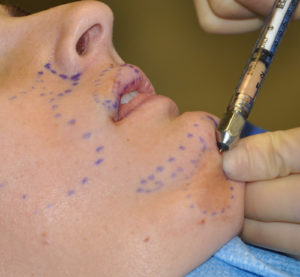Systemic Sclerosis is a chronic connective tissue disease that is characterized by subcutaneous fat atrophy, replacement by scar and poor vascularity. It has two main types, diffuse and limited. Limited or linear scleroderma most commonly affects the face and the extremities. As it occurs on the face it is better known to plastic surgeons as linear or localized sclerderoma
Linear scleroderma is the name given to a localized form of scleroderma when it occurs on the head or face in children. A classic presentation is when children develop a deep furrow from the scalp down into the forehead in a vertical fashion. The skin is atrophic, tight and whiter in color than the surrounding uninvolved skin. This appearance give it the name of coup de sabre or ‘cut of the saber’ by which it is often called.
Linear scleroderma occurs in diverse presentations. Some children and teenagers present with scalp and forehead lesions while others have it occur only on the chin or lip. A more severe form of it presents with involvement of the entire half of the face and is known as Parry Romberg syndrome. But some patients have variations or combinations of these scleroderma presentations which may defy these classic descriptions.
The cause of linear scleroderma is not known although the disease process appears to be consistent. It develops in childhood, is variably progressive and appears to cease or burn itself out by late teens or the early twenties. There is no known method to treat its progression once it appears although some forms of chemotherapy have been advocated. Treatment of the facial condition is largely cosmetic with soft tissue correction.
Over the past decade, I have treated a total of seven teenage and young adults with various forms of linear scleroderma (5) and Parry Romberg syndrome (2) by fat injections as the primary form of therapy. Because the soft tissue defects are characterized by loss of fat and skin thinning, their reconstructive treatment with concentrated fat injections seems logical and easily applied. Parry Romberg syndrome patients often have bony involvement and they were treated with facial bone implants of the cheek and jaw angles.

No complications occurred in either the face or the donor areas in any of the patients. Every patient showed some degree of sustained improvement by 3 months after treatment. No patient showed total loss of all injected fat and no reactivation of the scleroderma condition was seen by one year after treatment in any patient.
The success of injected fat in established linear facial scleroderma makes one wonder whether it would be similarly useful in treating the facial disease process when it appears to slow down or halt progression. It would be hard to see the harm in it as it is autogenous tissues. Perhaps the stem cells or cytokines in transplanted fat can turn off the tissue atrophy process. These results also suggests that it may useful in extremity ulcerations in systemic sclerosis as well. A few studies have reported on such success with the healing of digital (finger) ulcerations by direct fat injections.
Dr. Barry Eppley
Indianapolis, Indiana


